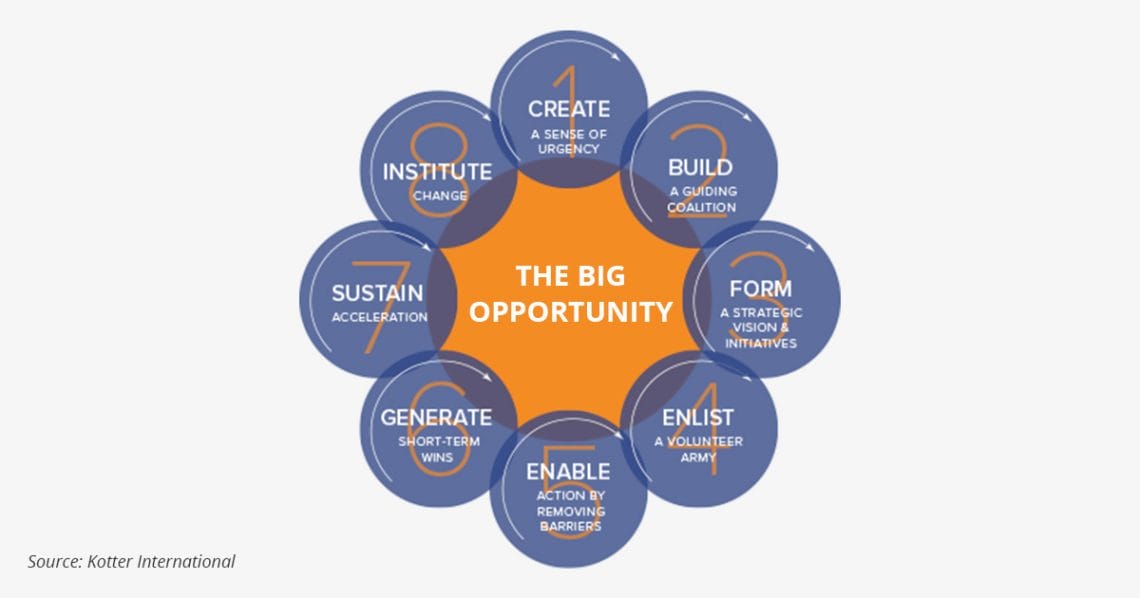
Use Kotter’s 8-Step Process for Leading Change to introduce a culture of learning
CLOs and their Learning and Development teams can play a significant role in leading organizational change by fostering a learning culture. Organizations that remain stagnant and unresponsive to the learning needs of their employees will not be able to respond to the needs of their customers.
Organizational change is not a new term but it has evolved through the years as the needs of customers and employees have changed. There are several classic organizational change models, including the McKinsey 7-S Framework, Kotter’s 8-Step Process for Leading Change, and Lewin’s Change Management Model, among others. Of these, I prefer Kotter’s model because it begins with the call to action to create a sense of urgency, which is what L&D needs to do in their organization. Incidentally, 2017 also marks the 21st anniversary of Kotter’s seminal book, Leading Change.
Here is Kotter’s methodology for leading organizational change, broken down from an L&D perspective. This process could take between six months to one year to implement depending on the size of your organization. You will notice that the process is scaffolded, whereby each steps builds on the previous ones.

1. Create a sense of urgency.
You will need to define “why” learning in an organization is mission critical. One of the biggest challenges facing the US economy today is the skills gap. Learning is critical for organizations if they want to stay relevant and profitable.
2. Build a guiding coalition.
Engage with your business leaders and executives to build peer support around Step 1. You must ensure your “why” is important to them, otherwise they will not see the value learning can bring to the organization and will not support you. You will need to leverage their perspective into a building a coalition of supporters around the importance of a learning culture in the overall organization.
3. Form a strategic vision.
With the stakeholders from Step 2, you will need to craft a strategic vision around making learning part of talent development. Incorporate tools and technology to reach your learners whenever and wherever they want to learn. Engage them, seek their perspective, and incorporate it when it’s part of the vision.
4. Enlist a volunteer army.
Here, you will need to use critical avenues to communicate the new vision and strategies to the individual learner and learner groups. These avenues may include social media, face to face meetings, focus groups, presentations, and demos. Through these avenues, you will build an “army” of supporters to your mission of making learning critical to the organization.
5. Enable action by removing barriers.
In this step, you will need to remove internal and external barriers to learning across the organization. The external are more difficult to impact. However, internally, you can take action, starting by discovering the on-the-job needs of the learner, what time they prefer to learn, how much time they dedicate to learning, and what they most want to learn.
6. Generate short term wins.
Select a small, enthusiastic, and committed group from Step 5 and implement new learning programs and technologies with them. Ensure that they are engaged and part the change. This will be your pilot or ‘proof of concept’. Pivot as needed and track the momentum of small wins. It is a good idea to share these small wins through social media posts from your early adopters – nothing speaks better of a new and successful initiative than documented results and stories from those who benefit.
7. Sustain acceleration.
In this step, you must continue the momentum with new content, new themes, and even giveaways to encourage your learners to continue making progress. As your results grow, be sure to track progress and report back to the executive team on these interim results.
8. Institute change.
Finally, you must complete a formal review of the results you’ve experienced regarding productivity, performance, and profitability as a result of the learning culture you have introduced. Share and report the progress to key stakeholders and celebrate any successes. It is always good idea to take time to reflect on the lessons learned and recalibrate for future initiatives.
Change is not easy, but it is the only way organizations can continue to drive success. Introducing a culture of learning is no small task, but using a well-planned strategy (e.g., the guiding steps above) can help ensure it’s an organizational change that will last.
Get more L&D insights from Marina Theodotou at DoceboInspire, our upcoming L&D conference!

About the author
Marina Theodotou is the director for professional development at the Computer Science Teachers Association and is pursuing a doctorate in education focusing on the alignment of learning and skills to organizational goals.
